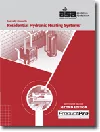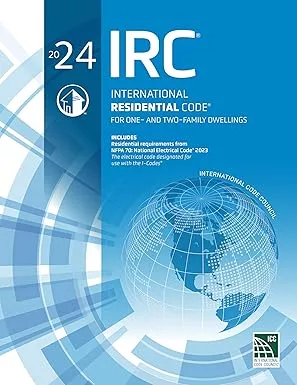Residential Sprinkler Systems
Many predicted the concept of installing a combination sprinkler system/potable water piping system would take hold immediately. Predictions that by the year 2000 every new home constructed would be equipped with a sprinkler system abounded. Fire deaths in homes would become a thing of the past. Between 4,000–6,000 lives a year would be saved.
So what happened? Why in 1998 do some statistics report that less than 1 percent of all new single-family dwellings constructed are equipped with a residential sprinkler system? And in homes that are protected with sprinklers, why are the majority of the systems not piped as combined systems?
A Wild 25 Years: If you review the past 25 years since the residential sprinkler idea was introduced, you would find that the concept has been attacked in every possible way. The opposition and lobbying against residential sprinklers has come from some of the strangest sources. One would naturally assume that the home builders associations would oppose residential sprinklers. However, their opposition has been rather mild. They don’t want residential sprinklers mandated by code. Home builders recognize the benefits of residential sprinklers and believe that the decision to install the systems should be left to the individual builder or home buyer. This is not an unreasonable request.
One of the biggest surprises has come from sprinkler contractor associations. Their opposition to combined systems has been very vocal. They have referred to the systems as quasi-sprinkler systems. They have also lobbied hard with fire officials, fire marshals, and state licensing boards in opposing the systems. As a result, many fire officials consider a combined sprinkler system to be substandard.
The opposition by sprinkler contractor associations has been basically a job protection issue. The groups have readily recognized plumbing contractors would install a combined system. So their opposition has been directed at plumbing contractors. The main thrust has been that plumbing contractors don’t have the expertise to properly locate sprinklers in the ceiling or sidewall. They believe sprinkler contractors know how to size the piping by hydraulic calculations, whereas plumbing contractors do not, and plumbing contractors will destroy the safety record of completely sprinkler-equipped buildings.
Of course, any plumbing contractor can easily respond to these comments as being bogus. If a plumbing contractor can properly locate a water closet, they certainly can properly locate a sprinkler. The sizing of a residential sprinkler system does not require the use of any sophisticated computer program; it’s rather easy to do. If the sprinkler system is installed in accordance with NFPA standards, then the safety record will not be jeopardized. Of course, this is required by code, and the system must be inspected by the building department.
Keep in mind, many sprinkler contractors do not have a problem with plumbing contractors getting into the residential sprinkler business. The majority of the sprinkler contractors concentrate on commercial installations. They recognize that when a system is piped as a part of the potable water system, the only logical contractor to install the system is a plumbing contractor. Besides, if every new home constructed was to have a sprinkler system, there are not enough sprinkler contractors in the country to handle the work load. Hence, they need plumbing contractors involved if the goal is to have every new home equipped with sprinklers.
The other surprising opposition comes from health officials, backflow specialists and plumbing code authorities. Although this opposition is not extensive, it has prevented the use of combined systems in many parts of the country. Their concern is the possible contamination of the potable water system. Rather than analyzing residential sprinkler systems separately, these systems have been lumped together with commercial sprinkler systems that are piped in black steel pipe.
When a combined system is reviewed for possible contamination of the potable water supply, it is obvious that such a system is no different than water piping installed for future fixtures. The system is piped as a part of the potable water piping system with the same piping material.
Now The Good News: Although it has been a bumpy ride, a lot of good news has come about to support the idea of installing sprinklers in every new home. In 1976, the first edition of NFPA 13D was published. This standard is quite unique in establishing requirements for installing a residential sprinkler system as a part of the potable water distribution system in one- and two-family dwellings. The system is technically referred to as a multi-purpose piping system. One purpose is to supply potable water, the other to protect against fire.
The majority of single-family dwellings in the United States can be equipped with sprinklers with the largest water supply pipe being 3/4 or 1 inch in diameter. NFPA 13D also eliminates the need for all of the special piping arrangements found on a typical commercial sprinkler installation. Once the single-family dwelling has smoke detectors installed, the system simply allows the sprinklers to connect directly to the potable water piping. There is no need for any gauges, check valves, fire department connections, water flow alarms or test assemblies. It takes little more than a few extra tees and some residential sprinklers (also called heads) to install the system.
In addition, manufacturers have been working to assist plumbing contractors in adapting plumbing systems to multipurpose piping systems. The newer sprinklers have lower flow rate demands and lower pressures. This allows the system to be piped with smaller diameter pipe. The sprinklers are also covering larger areas, reducing the number of sprinklers required to be installed.
A few years ago, a standard residential sprinkler had a water flow rate demand of 18 gpm and minimum pressure requirement of 16 psi. Some of the newer sprinklers have a water flow rate demand of 9 gpm with a pressure demand of 9 psi. This same sprinkler can cover an area 20 feet by 20 feet by increasing the flow rate to 14 gpm and the pressure to 21.8 psi.
Using these lower flow sprinklers, a single-family dwelling (of any size) can be equipped with sprinklers with the water piping being no larger than 3/4 inch in diameter. The 3/4–inch pipe can handle the demand required by NFPA 13D.
The manufacturers have also come out with more recessed sprinklers and different colored sprinklers. The recessed sprinklers hide the fact that the home is equipped with sprinklers. The only thing visible is a cover plate. For the colored sprinklers, there are standard colors, and for a price, some manufacturers will match the paint color of the home.
With 25 years of experience, plenty of statistics are available regarding residential sprinkler systems. The most promising statistic is there have not been any fire deaths in a home protected with a properly installed residential sprinkler system. Hence, if every dwelling unit in the United States was equipped with sprinklers, there would be a savings of 4,000–5,000 lives a year. That is a staggering number of lives that could be saved every year.
Unfortunately, the fire loss of life does not happen all at once. Fire deaths are normally one, two or three at a time. Imagine if there were 4,000 lives lost, all in one residential fire. There would be a national outcry to correct the situation.
One of the most unfortunate statistics comes from various polls taken of homeowners. The majority of the public is unaware that they can have sprinklers installed in their homes. When surveyed, some homeowners thought the sprinklers in question were lawn sprinklers. Many new homeowners would have installed residential sprinklers if they were aware of their existence.
The only way to correct the public perception is to promote residential sprinklers locally. Many contractors have adopted policies of installing sprinklers in a furnace or boiler room every time they change a water heater. Small promotions such as these increase public awareness. Many owners of older homes are often in the market for newly constructed homes. The selling starts with every service call.
The Next 25 Years: Some successful plumbing contractors installing residential sprinklers promote the payback of the system installation. When residential sprinklers were first installed, certain insurance companies increased the premiums for homeowners insurance. Their justification was that there is an increased risk of water damage from the false activation of a sprinkler.
The sprinkler industry helped to correct this inaccuracy. The probability of false activation is in the neighborhood of one in 3 million. The insurance companies changed their ways and started to offer reductions in premiums for homes that had residential sprinkler systems installed. There are stories of paybacks in five to seven years of reduced premiums. The payback is dependent on the size of the home and the cost of the insurance for the area.
We hope the next 25 years will be smoother sailing for residential sprinklers. In the year 2023, we should be able to look back and think how dumb we were for not installing residential sprinklers in every dwelling. Every plumbing contractor will not only have the capabilities of installing the systems, it will be a part of their apprenticeship training. State plumbing exams will include test questions on residential sprinklers.
If this seems far-fetched, think back to 1975 when someone predicted every home would have a computer by the year 2000. We are pretty close to that prediction. And by the way, computers cost more than the installation of a residential sprinkler system.
Looking for a reprint of this article?
From high-res PDFs to custom plaques, order your copy today!







